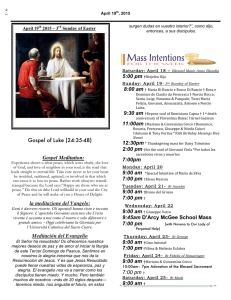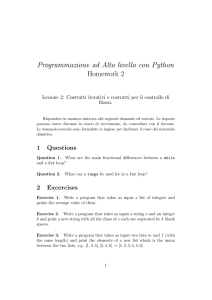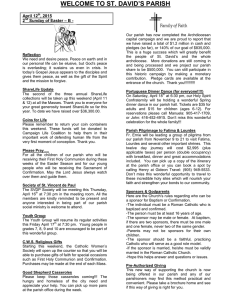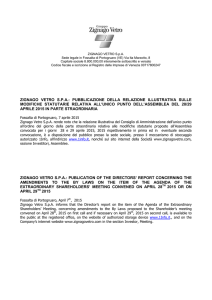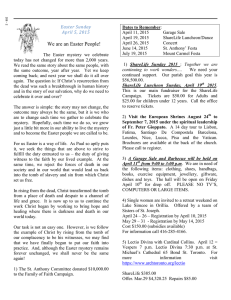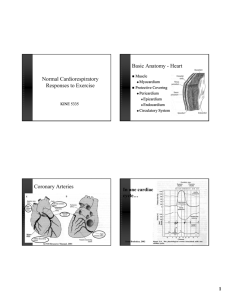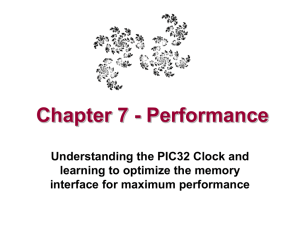EMC of ICs - Alexandre Boyer
advertisement
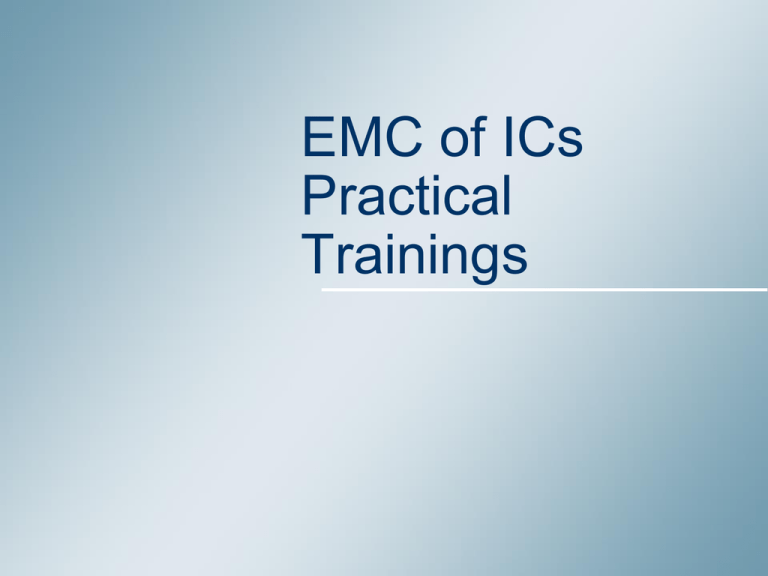
EMC of ICs Practical Trainings Objectives Get familiar with IC-EMC/Winspice Illustrate parasitic emission mechanisms Understand parasitic emission reduction strategies Power Decoupling Network modelling Basis of conducted and radiated emission modelling Basis of immunity modelling 2 April 15 Summary IC-EMC – Reference Basic concepts Ex. 1. FFT of typical signals Ex. 2. Transient current estimation Ex. 3. Interconnect parasitics Ex. 4. Impedance mismatch Ex. 5. Crosstalk Emission Ex. 6. di/dt noise Ex. 7. PDN modeling Case study: Optimization of Starcore PCB (ICEM model) 3 April 15 IC-EMC - Simulation flow IC-EMC schematic Editor (.sch) IC-EMC model libraries WinSPICE compatible netlist generation (.cir) WinSPICE simulation IC-EMC Post-processing tools (emission, impedance, S-parameters, immunity) Output file generation 4 April 15 Measurement import IC-EMC – Most Important Icons Open schematic (.sch) Build SPICE netlist (.cir) Save schematic (.sch) Spectrum analysis Delete symbols Near field emission simu. Copy symbols Immunity simulation Move symbols Time domain analysis Rotate symbols Impedance simulation Flip symbols S parameter simulation Add Text line Ibis file editor Add a line Parametric analysis View electrical net Symbol palette Zoom in/out View all schematic 5 April 15 IC-EMC – Link to WinSpice − Click on WinSPICE.exe − Click File/Open to open a circuit netlist (.cir) generated by ic-emc. − IC-EMC main commands (text line): Simulation command Command line Parameters Transient simulation .tran 0.1n 100n step + stop time DC simulation .DC Vdd 0 5 0.1 source + start + stop + step Small signal freq. analysis .AC DEC 100 1MEG 1G sampling + nb points + start + stop Load SPICE library .lib 65nm.lib Path and file name 6 April 15 Exercise 1. FFT of typical signals Create the schematic Set the source generator Transient simulation FFT by IC-EMC Simulate the FFT of a sinus and a square signal 7 7 April 15 Exercise 1. FFT of typical signals • FFT of a sinus source – Set the voltage generator properties: • Frequency = 1 GHz • Amplitude = 1 V Ex1-FFT-sinus.sch 8 8 April 15 Exercise 1. FFT of typical signals • FFT of a sinus source – – – – Type the simulation command: .tran 1n 50n Simulate the response in time domain. Compute the FFT. Does the FFT result correlate with theoretical result ? 9 April 15 Exercise 1. FFT of typical signals • FFT of a square current source – Set the generator properties – For example: • • • • Period = 10 n, PW = 4 n, Tr = 1n, Tf = 1 n V0 = 0 V, V1 = 1 V Ex1-FFT-Pulse.sch 10 April 15 Exercise 1. FFT of typical signals • FFT of a square source For a trapezoidal signal (Tr=Tf) For a square signal (Tr=0) c n sin n 2 A T ,n0 T n T A c0 T cn t sin n sin n r 2 A T T ,n0 tr T n n T T c0 11 A T April 15 Exercise 2. Transient current estimation • Standard cell inverter in CMOS technology • Typical load capacitance • Observe in time domain the current through Vss. Ex2-transient_inverter.sch 12 April 15 Exercise 2. Transient current estimation • Time domain simulation • Adjust scales (Autofit and zoom on time axis) 13 April 15 Exercise 2. Transient current estimation • What is the influence of the load capacitance (1 fF to 1 pF) ? Ipeak Rise time Cload Cload 14 April 15 Exercise 3. Interconnect parasitics – The core is mounted in a QFP64 package. – A pair of pins is dedicated to supply the core 12 mm 6 mm 1.5 mm 25 µm 0.7 mm 3.5 mm 0.22 mm Evaluate the electrical parasitic associated to the power supply pair. 15 April 15 Exercise 3. Interconnect parasitics Use Tools/Interconnects Parameters to evaluate R, L, C associated to package pins. Empirical estimation : • Lead : L = 0.5 nH/mm and C = 0.1 pF/mm • Bonding : L = 1 nH/mm o l 8h W L ln 2 W 4 h ol 4h L ln 2 r 16 April 15 Exercise 4. Impedance Mismatch – Let’s consider the following link between 2 digital inverters. No matching is placed at each termination. – The digital inverters are 74AHCT04, from NXP. The IBIS file ahct04.ibs is given. – Build a SPICE model to evaluate the signal integrity at each termination of this digital link. Section of the line Top layer (signal line + power) 35 µm W = 0.36 mm 1.6 mm FR4 (εr = 4.5) Bottom layer – GND plane 35 µm 5 V power supply + filtering 2nd inverter: input driver 1st inverter: output driver 1 MHz square signal 10 cm 120 Ω microstrip line 17 April 15 Exercise 4. Impedance Mismatch – From IBIS file, propose an equivalent model for input and output driver. Input – “File > Load IBIS” ahct04.ibs Output Package outline Functional diagram 18 April 15 Exercise 4. Impedance Mismatch Measured I(V) charac. Of output buffer – Proposed models for input and output driver. IBIS_buffer_out_carac_IV.sch Measured I(V) charac. Of input buffer IBIS_input_buffer_IV.Sch 19 April 15 Exercise 4. Impedance Mismatch – Verify the theoretical characteristic impedance of the microstrip line (“Tools > Interconnect Parameters”). – The following S11 measurements have been done: • Line open (zin-line120-open.s1p) • Line loaded by 51 Ω resistor (zinline120-load51.s1p) • Line loaded by 120 Ω resistor (zinline120-match.s1p) zin-line120-open.s1p zin-line120-match.s1p – Propose an equivalent model for the line. 20 April 15 Exercise 4. Impedance Mismatch Output driver – Build the complete electrical model of the digital link. – Simulate the transient response of signal at each termination of the link. – Validate your model from measurements: • • • • Rising waveform at output driver (rw_out_no_match.tran) Falling waveform at output driver (fw_out_no_match.tran) Rising waveform at input driver (rw_in_no_match.tran) Falling waveform at input driver (fw_in_no_match.tran) Input driver 21 April 15 Exercise 4. Impedance Mismatch Input driver – R matching – Two solutions are proposed to improve signal integrity: • • Place two 120Ω resistors at both line terminals Place one 120Ω resistor at output driver side, one 120Ω resistor and a serial 4.7 pF capacitor – Test the effect of both solutions. – Validate your models from measurements: • • • • Rising waveform at output driver (rw_out_matchR.tran and rw_out_matchRC.tran) Falling waveform at output driver (fw_out_matchR.tran and fw_out_matchRC.tran) Rising waveform at input driver (rw_in_matchR.tran and rw_in_matchRC.tran) Falling waveform at input driver (fw_in_matchR.tran and fw_in_matchRC.tran) Input driver – RC matching 22 April 15 Exercise 5. Crosstalk – Let’s consider the following link between 2 digital inverters (74AHCT04). No matching is placed at each termination. – A second line loaded by 47 Ω at each terminals is placed at close distance (2W) – Build a SPICE model to evaluate the crosstalk at each termination of the victim line (near-end and far-end). 1st inverter: output driver Victim line 23 Top layer (signal line + power) 2W W = 1 mm 35 µm W = 1 mm April 15 1.6 mm FR4 (εr = 4.5) Bottom layer – GND plane 5 V power supply + filtering 2nd inverter: input driver Aggressor line 1 MHz square signal Section of the line 35 µm Exercise 5. Crosstalk Near end – Build the complete electrical model of the coupled lines. – Simulate the transient response of signal at each termination of the victim line. – Validate your model from measurements: • • Near end crosstalk (NE_ctlk.tran) Far end crosstalk (FE_ctlk.tran) Far end 24 April 15 Exercise 6. di/dt noise – Estimate the voltage bounce on Vdd and Vss pins of the core when it is mounted in a QFP 64. – The core clock is 20 MHz. V ? Core noise margin ? Ex4-didt_noise.sch 25 April 15 Exercise 6. di/dt noise Vss 1 ohm (V) 0.08 0.07 10 mV 0.06 -5.0E-08 0.05 0.0E+00 Time (s) 26 5.0E-08 April 15 1.0E-07 Exercise 6. di/dt noise • Inductance evaluation Impedance vs. Freq z11-dspic-vdd_10-vss_9.z 27 April 15 Exercise 6. di/dt noise • What IBIS Says ? Typ min max R_pkg 19.05m 21.2m 16.9m L_pkg 3.025nH 2.61nH 3.44nH C_pkg 0.269pF 0.268pF 0.270pF 28 April 15 Exercise 7. PDN Modeling Impedance vs. Freq DSPIC Z(f): find an R,L,C model Tune to measurement file: z11-dspic-vdd_10-vss_9.z 29 April 15 Exercise 7. PDN Modeling z11-C1nF_0603.z 1nF discrete capacitance for DPI Impedance vs. Freq 30 April 15 Synthesis of Exercises 1 to 7 What did we learn ? 31 April 15
